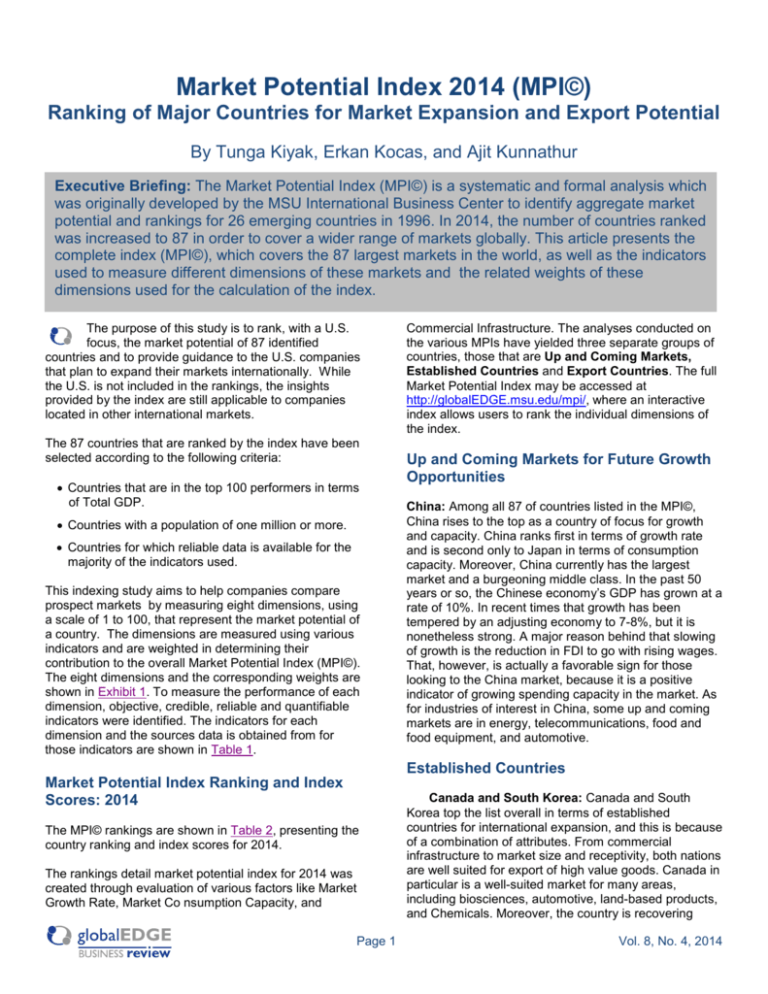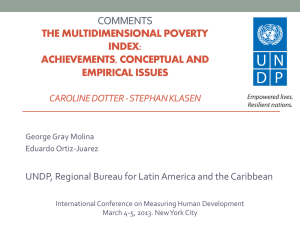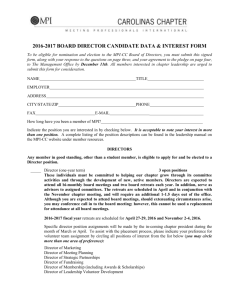Market Potential Index 2014
advertisement

Market Potential Index 2014 (MPI©) Ranking of Major Countries for Market Expansion and Export Potential By Tunga Kiyak, Erkan Kocas, and Ajit Kunnathur Executive Briefing: The Market Potential Index (MPI©) is a systematic and formal analysis which was originally developed by the MSU International Business Center to identify aggregate market potential and rankings for 26 emerging countries in 1996. In 2014, the number of countries ranked was increased to 87 in order to cover a wider range of markets globally. This article presents the complete index (MPI©), which covers the 87 largest markets in the world, as well as the indicators used to measure different dimensions of these markets and the related weights of these dimensions used for the calculation of the index. The purpose of this study is to rank, with a U.S. focus, the market potential of 87 identified countries and to provide guidance to the U.S. companies that plan to expand their markets internationally. While the U.S. is not included in the rankings, the insights provided by the index are still applicable to companies located in other international markets. The 87 countries that are ranked by the index have been selected according to the following criteria: • Countries that are in the top 100 performers in terms of Total GDP. • Countries with a population of one million or more. • Countries for which reliable data is available for the majority of the indicators used. This indexing study aims to help companies compare prospect markets by measuring eight dimensions, using a scale of 1 to 100, that represent the market potential of a country. The dimensions are measured using various indicators and are weighted in determining their contribution to the overall Market Potential Index (MPI©). The eight dimensions and the corresponding weights are shown in Exhibit 1. To measure the performance of each dimension, objective, credible, reliable and quantifiable indicators were identified. The indicators for each dimension and the sources data is obtained from for those indicators are shown in Table 1. Commercial Infrastructure. The analyses conducted on the various MPIs have yielded three separate groups of countries, those that are Up and Coming Markets, Established Countries and Export Countries. The full Market Potential Index may be accessed at http://globalEDGE.msu.edu/mpi/, where an interactive index allows users to rank the individual dimensions of the index. Up and Coming Markets for Future Growth Opportunities China: Among all 87 of countries listed in the MPI©, China rises to the top as a country of focus for growth and capacity. China ranks first in terms of growth rate and is second only to Japan in terms of consumption capacity. Moreover, China currently has the largest market and a burgeoning middle class. In the past 50 years or so, the Chinese economy’s GDP has grown at a rate of 10%. In recent times that growth has been tempered by an adjusting economy to 7-8%, but it is nonetheless strong. A major reason behind that slowing of growth is the reduction in FDI to go with rising wages. That, however, is actually a favorable sign for those looking to the China market, because it is a positive indicator of growing spending capacity in the market. As for industries of interest in China, some up and coming markets are in energy, telecommunications, food and food equipment, and automotive. Established Countries Market Potential Index Ranking and Index Scores: 2014 The MPI© rankings are shown in Table 2, presenting the country ranking and index scores for 2014. The rankings detail market potential index for 2014 was created through evaluation of various factors like Market Growth Rate, Market Co nsumption Capacity, and Page 1 Canada and South Korea: Canada and South Korea top the list overall in terms of established countries for international expansion, and this is because of a combination of attributes. From commercial infrastructure to market size and receptivity, both nations are well suited for export of high value goods. Canada in particular is a well-suited market for many areas, including biosciences, automotive, land-based products, and Chemicals. Moreover, the country is recovering Vol. 8, No. 4, 2014 well from the global economic recession, returning to levels of GDP growth around 2.5%. That is third among industrialized nations, behind only the U.S. and the UK. Given the strong trade relationship with the U.S., Canada is an excellent choice for companies looking to expand with mitigated risk. South Korea is a country that has changed dramatically over the past 40 years, generating astounding growth and achieving status as an industrialized nation. Today, the country is experiencing modest growth in GDP of 2%, has an incredibly low unemployment of 3.2%, and has been transformed into a high-tech economy. Industry areas of note are in the biosciences, automotive sector, medical devices sector, and advanced manufacturing. Furthermore, South Korea has reached historical import highs in 2013, which is good news to for companies looking to get into the market. The South Korean market is a good bet for companies looking to capitalize on a high-tech industrial and consumer market, as well as those companies focusing on raw material exports. Export Countries Switzerland, Austria, and The Netherlands: These countries embody markets that are not all that substantial in and of themselves but have the potential to serve as re-export bases for access to other markets. Switzerland is an interesting opportunity; this is because for many industries it serves as an established market, such as for biosciences and medical devices. Industries involving energy, chemicals, chemicals, and machinery are those that Switzerland is most involved in for export. Primary export partners include some of the largest economies in Europe, those of Germany, France, and Italy. Austria serves as another excellent re-export market, having been inducted into the EU in 1995. Particularly for the European market, Austria services as an excellent test marketing arena. In terms of exports, Austria’s industry focus is in the automotive and petroleum energy sector. As with Switzerland, major export partners are Germany, Italy, and France. The Netherlands tops of this list of countries, with nearly 30% of its income coming from exports alone. The value of those exports came to 86.7% of GDP in 2012. As with Page 2 Austria, the Netherlands is also an EU member. Areas of focus for export from the Netherlands are in the landbased products industry and commercial services; major export partners include Germany, Belgium, China, the UK, and France. A commonality among all these countries is that they have less restrictive trade policies than much of the world due to their smaller economic footprint. Export is a major part of their respective economic engines, and for U.S. companies that can be an effective means of evaluation and entry into larger markets. Conclusion The International Business Center at MSU publishes MPIs on a yearly basis with a talented team of graduatelevel students and professors updating metrics continuously. We have analyzed the overall MPI© through a grouping methodology to categorize opportunities by market type. This provides a good starting point for U.S. companies to evaluate the overall market potential in determining particular nations for expansion. For a more detailed review of all nations in the MPI© that are of particular interest, please visit http://globalEDGE.msu.edu/mpi/. The interactive features embedded into the MPI© will allow you to evaluate countries based on eight distinct dimensions identified to determine overall ranking. ♦ gBR Article 08-04, Copyright 2014. About the Authors This study has been conducted by the International Business Center (IBC) MPI Team under the supervision of Tunga Kiyak, Managing Director of the Academy of International Business and Outreach Coordinator of MSU-CIBER (International Business Center). IBC MPI Team Members: • Erkan Kocas – Research Associate, MSU IBC nd • Ajit Kunnathur – 2 year MBA Student, Eli Broad College of Business Vol. 8, No. 4, 2014 Exhibit 1: Market Potential Index Dimensions and Weights Country Risk, 7.50% Economic Freedom, 7.50% Market Size, 25% Market Receptivity, 10% Commercial Infrastructure, 10% Market Intensity, 15% Market Consumption Capacity, 12.50% Market Growth Rate, 12.50% Note: The percentage (%) by each dimension is the weighting of the dimension. Page 3 Vol. 8, No. 4, 2014 Table 1: Dimension Indicators and Sources Dimension Measures Used Market Size • • Electricity Consumption (2011) 1 Urban Population (2012) Market Intensity • • GNI per Capita Estimates Using PPP (2012) 1 Private consumption as a percentage of GDP (2012) • • Average Annual Growth Rate of Primary Energy Use (Between 2 Years 2007-2012) 1 Real GDP Growth Rate (2012) • • Consumer Expenditure (2013) 1 Income Share of Middle-Class (2011) • • • • • • • Cellular Mobile Subscribers (2012) 3 Households with Internet Access (2012) 3 Main Telephone Lines (2012) 4 Number of PC's (2012) 4 Paved Road Density (2013) 4 Population per Retail Outlet (2013) 4 Percentage of Households with Color TV (2013) Market Receptivity • • Per Capita Imports from US (2013) 1 Trade as a Percentage of GDP (2012) Economic Freedom • • Economic Freedom Index (2014) 6 Political Freedom Index (2013) • • • Business Risk Rating (2014) 9 Country Risk Rating (2013) 10 Political Risk Rating (2014) Market Growth Rate Market Consumption Capacity Commercial Infrastructure Country Risk 1 1 4 3 7 5 8 Data used are those available for most recent year. All sources were accessed in April 2014. • • • • • • • • • • 1 Source: World Bank, World Development Indicators Source: U.S. Energy Information Administration, International Energy Annual 3 Source: International Telecommunication Union, ICT Indicators 4 Source: Euromonitor International, Global Market Information Database 5 Source: Heritage Foundation, The Index of Economic Freedom 6 Source: Freedom House, Survey of Freedom in the World 7 Source: U.S. Census Bureau Foreign Trade Division, Country Trade Data 8 Source: Swiss Export Risk Insurance, Cover Practice for Countries and Banks 9 Source: Coface, Economic Studies 10 Source: Credimundi, Country Risks 2 Page 4 Vol. 8, No. 4, 2014 Table 2: Market Potential Index Rankings 2014 Country China Hong Kong SAR, China Japan Canada Singapore Germany India Switzerland United Kingdom Korea, Rep. France Australia United Arab Emirates Norway Russian Federation Austria Netherlands Belgium Sweden Brazil New Zealand Denmark Ireland Italy Mexico Finland Qatar Poland Latvia Israel Spain Chile Slovakia Lithuania Malaysia Turkey Saudi Arabia Slovenia Indonesia Czech Republic Kuwait Uruguay Bulgaria Romania Thailand Hungary Philippines Costa Rica Oman Vietnam Peru El Salvador Bangladesh Overall Rank Market Size Market Intensity Market Growth Rate Market Consumption Capacity Commercial Infrastructure Market Receptivity Economic Freedom Country Risk 1 2 3 4 5 6 7 8 9 10 11 12 13 14 15 16 17 18 19 20 21 22 23 24 25 26 27 28 29 30 31 32 33 34 35 36 37 38 39 40 41 42 43 44 45 46 47 48 49 50 51 52 53 1 53 3 11 57 6 2 50 12 10 8 20 42 39 4 48 33 38 34 5 61 62 69 13 9 44 70 27 84 51 16 37 67 80 31 15 19 81 7 45 58 77 59 43 26 54 24 78 71 30 35 75 25 85 1 12 7 13 10 70 2 4 44 17 15 30 5 66 11 32 22 27 57 28 24 53 16 35 18 43 45 36 42 23 38 48 31 72 25 81 40 74 58 68 33 51 56 71 39 47 54 73 67 65 3 46 1 50 65 57 23 66 20 62 72 36 69 52 2 47 27 63 77 64 61 45 49 79 75 84 46 76 19 54 43 37 83 10 60 78 16 41 3 82 13 73 6 22 68 55 11 80 17 29 18 7 9 53 8 2 68 1 7 61 3 10 24 5 9 4 8 56 22 16 17 13 32 14 41 43 12 37 6 50 21 69 26 39 42 11 81 25 52 70 27 54 31 38 23 66 74 20 15 57 33 64 79 67 49 73 75 45 56 7 24 14 21 11 83 15 12 28 8 6 16 22 23 5 20 26 13 52 17 9 1 33 67 18 34 39 4 37 29 55 41 2 47 58 19 3 77 32 38 49 43 48 64 46 79 54 42 59 81 60 82 77 1 78 3 2 31 76 8 44 24 59 47 4 40 80 29 6 5 38 85 49 32 7 65 19 43 9 46 27 21 64 34 13 14 12 70 33 25 81 16 30 60 26 63 20 11 67 23 36 18 71 45 79 82 1 17 5 16 12 53 3 10 28 31 2 60 20 78 17 11 21 14 47 4 8 7 35 43 12 58 25 33 29 24 6 27 15 46 48 76 34 52 19 66 22 36 37 56 30 51 26 62 81 38 39 65 18 2 3 3 1 10 41 3 21 10 21 10 31 3 40 10 21 21 3 35 10 10 21 49 32 10 17 21 46 38 49 20 21 29 8 56 29 36 41 36 8 52 46 46 54 57 32 41 18 61 32 55 69 Page 5 Vol. 8, No. 4, 2014 Serbia Bahrain Estonia Tunisia Croatia Argentina Portugal Morocco Egypt, Arab Rep. Kazakhstan Dominican Republic Cyprus Pakistan Colombia Nicaragua Ukraine South Africa Sri Lanka Greece Cambodia Ecuador Belarus Guatemala Venezuela Honduras Algeria Paraguay Iraq Azerbaijan Uzbekistan Papua New Guinea Nigeria Myanmar Cuba 54 55 56 57 58 59 60 61 62 63 64 65 66 67 68 69 70 71 72 73 74 75 76 77 78 79 80 81 82 83 84 85 86 87 63 82 85 64 73 23 52 40 22 41 66 86 17 28 79 21 18 76 49 83 55 56 65 29 74 32 72 36 68 46 87 14 47 60 37 79 59 41 52 63 20 69 21 77 9 8 26 62 19 50 60 55 6 29 64 76 14 61 34 86 49 83 84 75 80 82 78 70 33 87 38 71 12 85 14 28 40 32 74 35 34 30 81 51 24 86 26 15 58 48 21 44 31 67 4 59 25 39 56 5 42 28 72 48 44 46 55 51 63 34 30 77 71 36 83 62 18 86 59 29 60 78 19 85 58 84 40 80 35 47 53 82 76 65 45 25 10 69 30 50 36 62 65 35 75 40 72 66 80 44 51 70 31 73 61 27 74 57 76 68 71 78 53 63 85 86 87 84 48 15 10 41 53 82 56 52 83 58 51 50 86 75 37 39 69 73 72 35 54 17 62 66 22 68 42 55 57 74 28 61 87 84 44 55 9 57 40 67 31 68 77 69 45 23 71 42 59 72 41 63 50 75 70 84 54 85 64 79 49 80 74 86 61 73 83 87 67 51 21 66 59 78 57 41 77 59 64 74 81 39 76 86 52 69 74 79 72 82 61 85 69 41 61 82 68 79 64 73 82 86 Note: Access the full interactive Market Potential Index at http://globalEDGE.msu.edu/mpi/ Page 6 Vol. 8, No. 4, 2014







